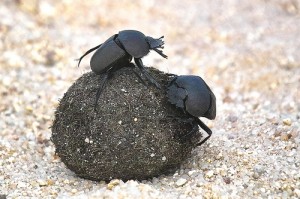Dung beetles: courtship behaviour and how the horny males differ
Onthophagus binodis, a specie of dung bettles, have dimorphic males: large males have horns while small males do not (Cook, 1990). The following information is obtained through an experiment involving 96 observations.
During courtship, after initial physical contact between a male and a female, the male would perform “distinct upward jerks of the head and pronotum while still in contact with or close by the female.” (Cook, 1990). After this initial stage, the next involves the male constantly stimulating the female using its forelegs and midlegs while attempting to climb onto the female. The female sometimes moved after the male had started climbing, causing them to face opposite directions. However, the male will still continue stimulating the female as it rights itself. Eventually, the male inserts its parameters into the genital opening (Cook, 1990).
Copulation starts, and the male will still continue stimulating the female occasionally. It ends when the male retracts its aedeagus, and this is immediately followed by the male jerking like how it did during courtship (Cook, 1990).
The difference in courtship behaviour is mainly exhibited in the first stage. At 82%, horned males have a significantly higher chance to jerk while in contact with the female, compared to the 56% displayed by hornless males. Among those who maintain contact, 78% of horned males jerk while contacting the female head-on, as compared to only 39% among the hornless males (Cook, 1990).
Out of 82% of horned males which initiated courtship behaviour, 13% inseminated the female. When compared to the 97% and 61% respectively for hornless males (Cook, 1990), this is a very interesting result. It implies that horned males might be much more selective than hornless males when choosing a mate. However, in a natural environment, due to the competition between horned and hornless males, the hornless males will likely have much lesser chances to mate with females. In other words, they cannot afford to be picky.
References:
D.F. Cook, 1990. Differences in courtship, mating and postcopulatory behaviour between male morphs of the dung beetle Onthophagus binodis Thunberg (Coleoptera: Scarabaeidae), Animal Behaviour, 1990, 40, 428-436
“IMG13232 Dung beetles,” by Arno Meintjes Wildlife. Flickr, 22 Oct 2007. URL:
http://www.flickr.com/photos/arnolouise/3687032046/sizes/m/in/photostream/ (accessed on 10 Apr 2013).
